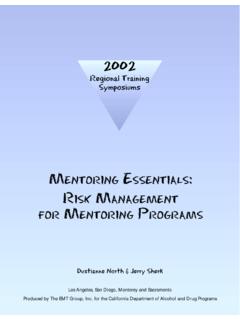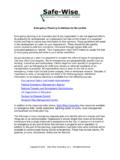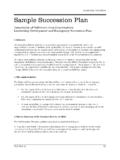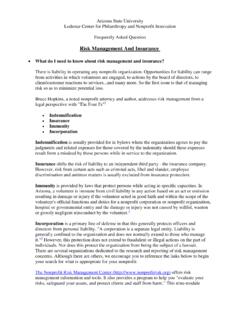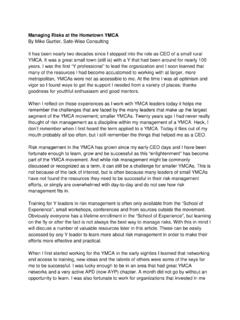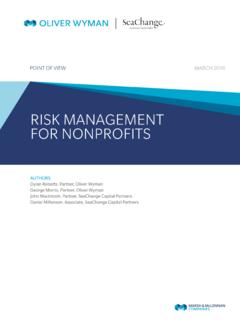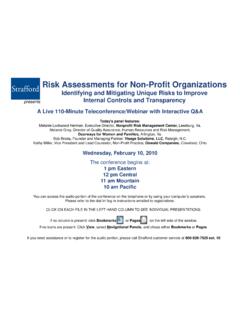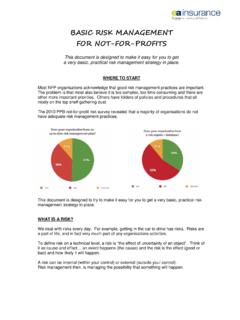Transcription of Nonprofit Risk Management & Contingency Planning - ijova.org
1 THE INTERNATIONAL JOURNAL OF VOLUNTEER ADMINISTRATION Volume XXIV, Number 5 July 2007 44A Review of Nonprofit Risk Management & Contingency Planning Done In A Day Strategies Hoboken, NJ: John Wiley & Sons, Inc., 2006. Hardback. 193 pages. ISBN-13: 978-0-471-71749-2 Reviewed by Mary Kay Hood Peggy Jackson provides excellent guidance for the non-profit looking to develop a risk Management and business continuity plan. Her model of providing DIAD (Done In A Day) Planning gives those who know nothing about risk Management Planning the opportunity to accomplish the task without being mired in the minutiae. The book is divided into three sections, the first addressing risk managment Planning , the second discussing continuity Planning , and the third discussing how risk Management and Contingency business Planning adds value to any non profit.
2 In the first section, keenly aware of some mind-boggling myths relative to risk Management , Jackson identifies and offers solutions to remove barriers hindering effective risk Management . She identifies four components common to all organiza-tions when considering risk Management Planning : 1) board members, 2) staff and volunteers, 3) operations and 4) relation-ships with the public. With these areas identified, Jackson suggests three primary steps surrounding effective risk Management Planning : 1) assessing the risk within the organization, 2) offering up and dealing with strategies relative to the identified risk, and 3) monitoring the activities surrounding the identified risk. Jackson further identifies four strategies for addressing risks : 1) Avoidance just say no to the identified activity that might bring risk; 2) Retention setting up funds to deal with identified risk when it happens, 3) Modification changing of policies or processes to ensure that risk is minimized; and 4) Transfer using the insurance or other entities to deal with risk when it happens.
3 According to Jackson, the organization knows that the risk Management Planning process has been accomplished when: everyone is on the same page ; it is ongoing; the organization has partnered with external advisors (legal, insurance, etc.); and there is a holistic, hands-on and all-inclusive approach to risk Management . The risk Management template recognizes constraints of staff, time and dollars with an emphasis on prioritizing the risks once they are identified. Jackson offers up practical tools for selecting the strategy for dealing with risk by walking through what to think about. The DIAD template guides the reader through what work needs to be accomplished ahead of time recog-nizing that the success of the DIAD is dependent upon the pre- Planning and prep work, complete with a timeline. The chapter with the template also outlines basic parameters for conducting the work to accomplishing this in a day.
4 The template is detailed, with outlined sample agendas, and instructions for conducting the DIAD session with approximate time estimations to keep the process on track. The second section of the book surrounds the unpleasant task of dealing the continuity business Planning , something that most people don't want to think about. The three components for this process include: 1) the crisis incident Management component ; 2) the business resumption component; and 3) the emergency fund raising component . With concrete examples of things that can interrupt normal business, one of the most important steps in dealing with a crisis should be a crisis communication plan. THE INTERNATIONAL JOURNAL OF VOLUNTEER ADMINISTRATION Volume XXIV, Number 5 July 2007 45 Jackson provides pragmatic components of a plan by outlining the necessary parts to make the plan effective.
5 This section also offers insight into which strategies to focus on to resume business operations should some disaster occur. With the business Contingency plan, preparation work should consider keeping everyone safe, financing the resumption of business, consideration of the impact of neighboring businesses, the information technology infrastructure, family emergency preparedness, and vendors and supplies. Crisis incident Management strategies addressed include: 1) crisis incident Management leadership; 2) emergency situations; 3) crisis communi-cations plans; 4) evacuation Planning , 5) emergency fundraising; 6) determining the extent of the damage; and 6) non-profit expectation of staff and volunteers. Sensitive to the proprietary information required for maintaining a business plan, Jackson offers advice on who should have what informa-tion and the detail that information should include.
6 She also challenges the reader to think about who and what is considered essential business functions, identifying key Management functions, people and resources to accomplish the work of getting the business back up and running with a time-line and sequence. Once again, the DIAD template guides the reader through what work needs to be accomplished complete with a timeline. The third and final section brings the reader full circle by discussing how to get everyone on the same page with appropriate training. This is where the return on the investment pays off. Should a situation happen, everyone knows what to do, how to react and get the non-profit back to day-to-day business. To accomplish this, Jackson suggests: z Curriculum is designed in such a fashion to incorporate assessment techniques to ensure everyone understands the process.
7 She offers up a sample training agenda for risk Management as well as business Contingency Planning . z There should be hands-on training exercises. Most often, the reader is aware of the fire drills that are most common but those hands-on training exercises should be more encom-passing of other types of things that could interrupt normal business. z Desktop exercises with examples to be used that could potentially happen during normal business hours, after business hours or at multiple loca-tions. This allows for the Planning to be throughout the organization considering all scenarios, at all levels. The return on investment discussion also illustrates what's necessary to be in compli-ance with current legislation. By raising awareness and commitment to reducing potential loss and damage, the non-profit organization needs to consider worse case scenarios.
8 Once they have been identified, then the organization plans proactively for them. Written in an easy to read fashion, this book helps any Nonprofit accomplish those tasks with templates and guides for getting it done in a day! Mary Kay Hood is the Director of Volunteer Services at Hendricks Regional Health. She is a national speaker on all aspects of volunteer Management and author of The One Minute Answer to Volunteer Management Questions. Mary Kay has a Master of Science degree and is currently president of the state healthcare DOVIA, Indiana Society of Director of Volunteer Services (ISDVS).

